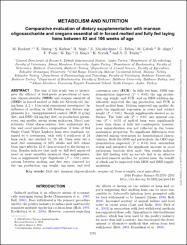Comparative evaluation of dietary supplementation with mannan oligosaccharide and oregano essential oil in forced molted and fully fed laying hens between 82 and 106 weeks of age
| dc.contributor.author | Bozkurt, Mehmet | |
| dc.contributor.author | Bintaş, Erol | |
| dc.contributor.author | Kırkan, Şükrü | |
| dc.contributor.author | Akşit, Hasan | |
| dc.contributor.author | Küçükyılmaz, Kamil | |
| dc.contributor.author | Erbaş, Göksel | |
| dc.contributor.author | Çabuk, Metin | |
| dc.contributor.author | Akşit, Dilek | |
| dc.date.accessioned | 2019-10-03T12:01:07Z | |
| dc.date.available | 2019-10-03T12:01:07Z | |
| dc.date.issued | 2016 | en_US |
| dc.identifier.issn | 0032-5791 | |
| dc.identifier.issn | 1525-3171 | |
| dc.identifier.uri | https://doi.org/10.12697/10.3382/ps/pew140 | |
| dc.identifier.uri | https://hdl.handle.net/20.500.12462/6671 | |
| dc.description | Akşit, Hasan (Balikesir Author) | en_US |
| dc.description.abstract | The aim of this study was to investigate the efficacy of feed-grade preparations of mannan oligosaccharides (MOS) and oregano essential oil (OEO) in forced molted or fully fed 82-week-old, laying hens. A 2 x 3 factorial experiment investigated the influence of molting vs. full feeding and dietary supplements [i.e., unsupplemented control, MOS (1 g/kg) diet, and OEO (24 mg/kg) diet] on production parameters, egg quality, serum stress indicators, blood constituents, tibial characteristics, liver antioxidant status, and cecal microflora composition. A total of 864 Single Comb White Leghorn hens were randomly assigned to 6 treatments, each with 6 replicates of 24 hens each, and studied for 25 wk. Hens were fed a molt diet containing of 50% alfalfa and 50% wheat bran (aa+wb) for 12 d, then returned to the laying ration. Results indicate that molt vs. full feed impacted more on most variables measured than supplementation or supplement type. Significant (P < 0.01) interactions between molting and diet were observed for the egg production, egg weight, egg mass, and feed conversion ratio (FCR). In fully fed hens, MOS supplementation improved (P < 0.01) the egg production, egg weight, and FCR, and an OEO addition significantly improved the egg production and FCR in forced molted hens. Molting improved egg quality despite the significant regression in ovary and oviduct weight (P < 0.01), though supplements showed no influence. The bone ash (P < 0.01) and mineral content (P < 0.05) of molted hens were significantly lower than those of fully fed counterparts; however, poor mineralization was not reflected in the bones' mechanical properties. No significant differences were observed among treatments for hematological characteristics. Both the MOS and particularly the OEO supplementation improved (P < 0.01) liver antioxidant status and mitigated the significant increase in cecal pathogenic bacteria after molt. Our results indicate that full feeding with an aa+wb diet is an effective non-feed-removal method for molted hens, the benefit of which can be improved with MOS and OEO supplementation. | en_US |
| dc.description.sponsorship | Republic of Turkey Ministry of Food, Agriculture and Livestock | en_US |
| dc.language.iso | eng | en_US |
| dc.publisher | Oxford Univ Press | en_US |
| dc.relation.isversionof | 10.3382/ps/pew140 | en_US |
| dc.rights | info:eu-repo/semantics/openAccess | en_US |
| dc.subject | Molt Diet | en_US |
| dc.subject | Mannan Oligosaccharide | en_US |
| dc.subject | Oregano Oil | en_US |
| dc.subject | Bone Strength | en_US |
| dc.subject | Cecal Microflora | en_US |
| dc.title | Comparative evaluation of dietary supplementation with mannan oligosaccharide and oregano essential oil in forced molted and fully fed laying hens between 82 and 106 weeks of age | en_US |
| dc.type | article | en_US |
| dc.relation.journal | Poultry Science | en_US |
| dc.contributor.department | Veteriner Fakültesi | en_US |
| dc.contributor.authorID | 0000-0002-1839-754X | en_US |
| dc.contributor.authorID | 0000-0002-8602-2280 | en_US |
| dc.contributor.authorID | 0000-0001-5430-9917 | en_US |
| dc.contributor.authorID | 0000-0001-6595-7821 | en_US |
| dc.identifier.volume | 95 | en_US |
| dc.identifier.issue | 11 | en_US |
| dc.identifier.startpage | 2576 | en_US |
| dc.identifier.endpage | 2591 | en_US |
| dc.relation.publicationcategory | Makale - Uluslararası Hakemli Dergi - Kurum Öğretim Elemanı | en_US |
Bu öğenin dosyaları:
Bu öğe aşağıdaki koleksiyon(lar)da görünmektedir.
-
Klinik Öncesi Bilimler-Makale Koleksiyonu [111]
Article Collection -
Pubmed Makale Koleksiyonu [917]
Pubmed Article Collection -
Scopus İndeksli Yayınlar-Makale Koleksiyonu [4845]
Article Collection -
Temel Bilimler-Makale Koleksiyonu [109]
Basic Sciences-Article Collection -
Temel Tıp Bilimleri-Makale Koleksiyonu [279]
Internal Medicine-Article Collection -
WOS İndexli Yayınlar-Makale Koleksiyonu [4825]
WOS Indexed Publications-Article Collection


















